Favorite Kosher Dill Pickles
Our family’s Favorite Kosher Dill Pickles – Homemade with fresh cucumbers, dill, and garlic. Tested and approved safe canning recipe for shelf stable storage.
I’ve been “puttin’ up” again, y’all! This time it’s our favorite kosher dill pickle recipe. And when I say favorite, I really mean these are a favorite.
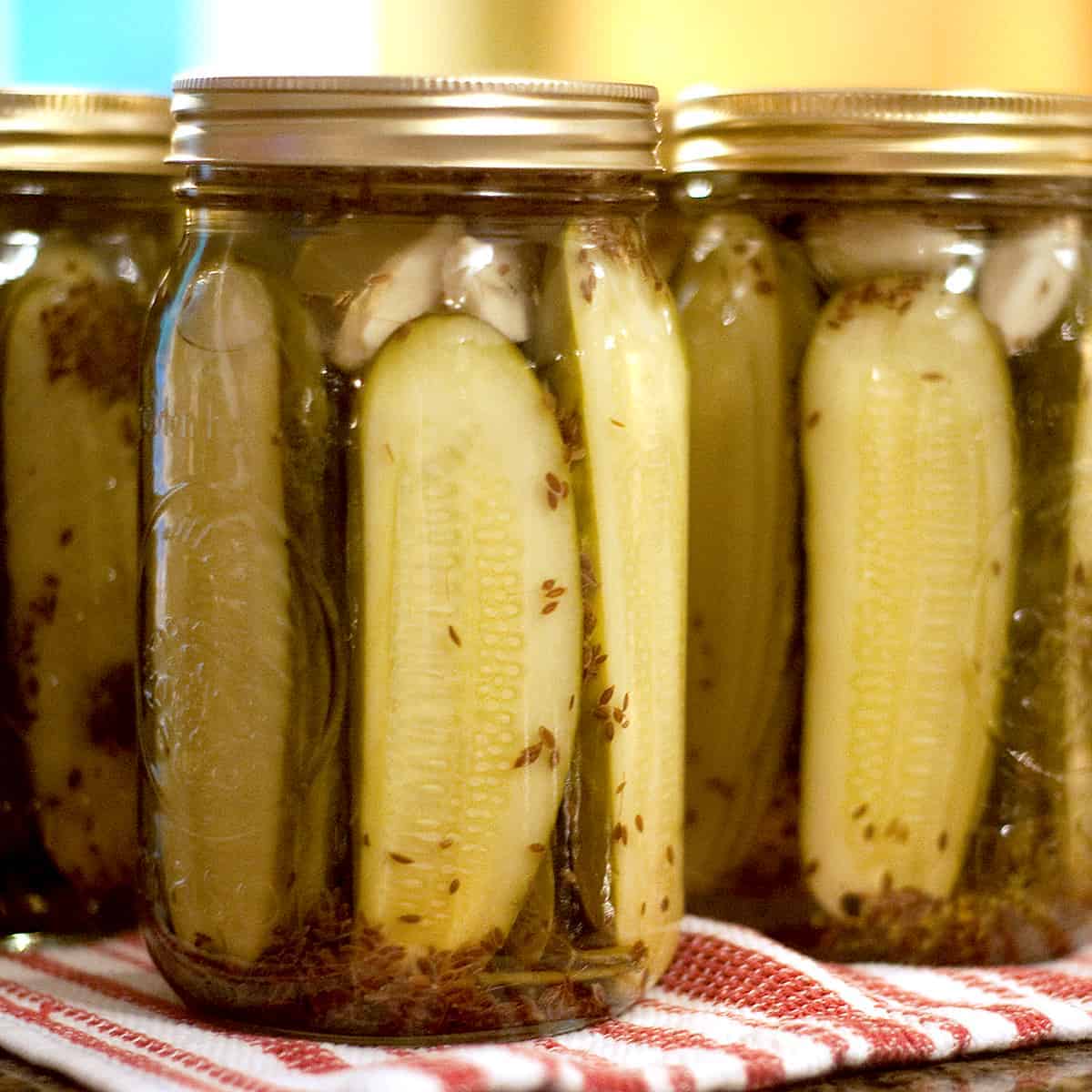
My daughter and grandson almost beg for these pickles every year. As a matter of fact, my old recipe notes say that the summer before our grandson was born, I put up 30 quarts of these dills. By the time he arrived in September over half of them were gone.
I have lots of pickling and preserving recipes like my Pickled Okra, Basic Salsa, and Home Canned Tomatoes. Some I make only occasionally, but these Kosher Dills are a must for every summer!
⚠️ Use Proper Canning Procedures
Before I get started with the recipe, I want to take a minute to mention the importance of using proper canning procedures. If you haven’t canned before, or if it’s been a while since your last canning session, please review the process and get all your equipment ready before you start.
One of the best resources for new and seasoned canners alike is the Ball Blue Book. It’s published by the people who make the Ball canning jars. It’s available in lots of locations and on the web at amazon.com.
📔 Some Other Good Online Resources
- National Center for Home Food Preservation (University of Georgia)
- Home Food Preservation Site (Pennsylvania State University)
- The USDA Complete Guide to Home Canning
The National Center for Home Food Preservation even offers a free online course in food preservation. It’s well worth the time for the amount of information you get!
Now, let’s get started making Kosher Dill Pickles!
🛒 Ingredient Notes
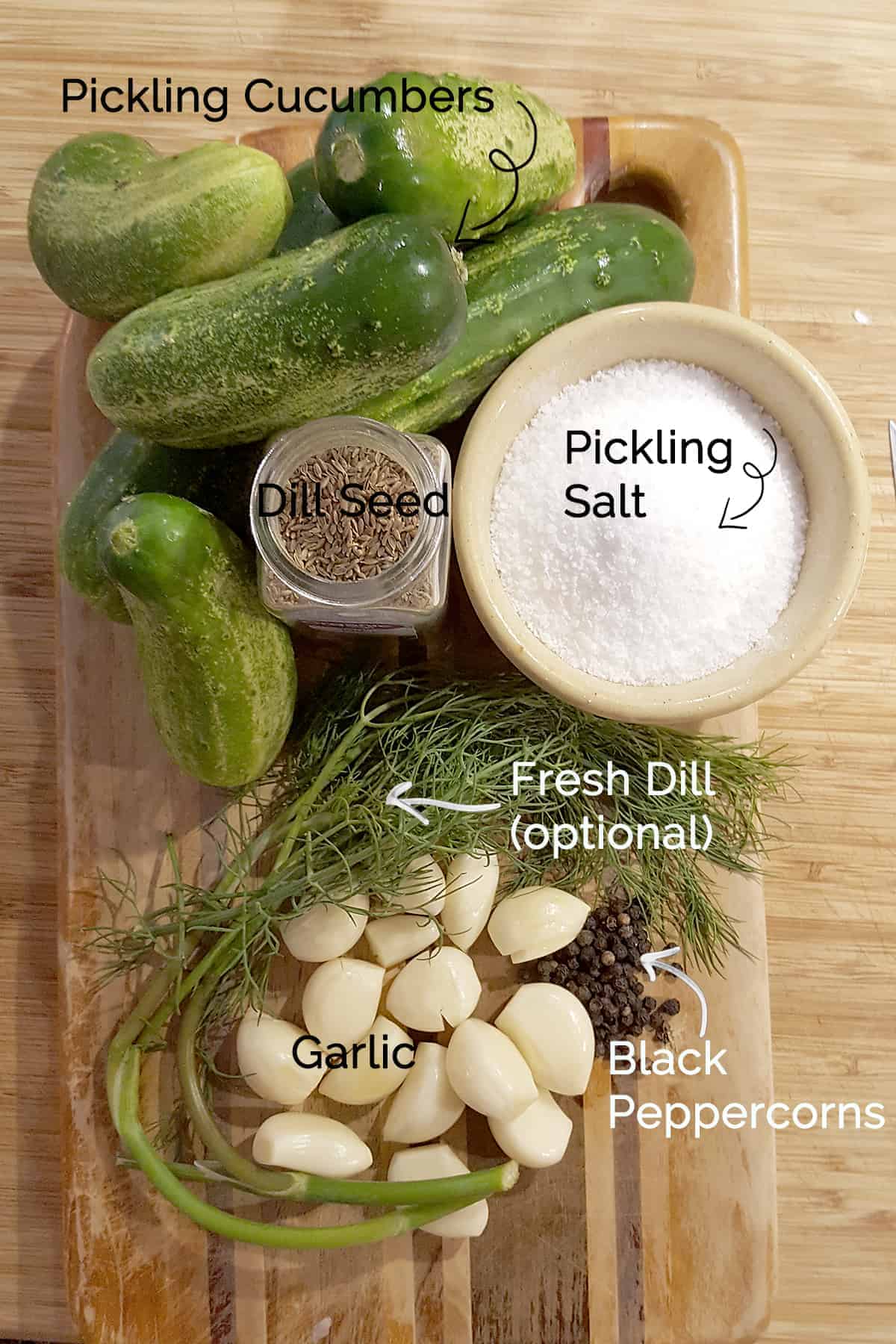
This post contains affiliate links. Lana’s Cooking is reader-supported and earns a tiny commission at no extra cost to you when you shop from our links.
For each quart jar of pickles, you’ll need approximately 5 pickling (or Kirby) cucumbers, one tablespoon of pickling salt, one tablespoon of dill seed (or 3 heads of fresh dill), a sprig or two of fresh dill fronds (optional), five black peppercorns, and two nice fat garlic cloves.
When purchasing your produce, keep in mind that a full boiling water canner can hold seven quart or pint jars. So, if you want to make a full canner load of pickles be sure to purchase enough produce for seven jars.
I tend to use quart jars for kosher dills because they fit the cucumbers best. Pickling (or Kirby) cucumbers are typically no more than 6 inches in length and will fit easily into quart jars.
Pickling (or Kirby) Cucumbers
For making pickles, you will need to find pickling cucumbers, also called “Kirby” cucumbers. You absolutely don’t want waxed cucumbers or English cucumbers for your pickling recipe.
Although “Kirby” is a specific variety of cucumber, these days any pickling cucumber tends to be referred to as a Kirby cucumber. They’re the shorter, plumper, sort of stubby looking cucumbers with a prickly surface. I’ve seen these called salad cucumbers in some produce sections but technically they’re simply pickling cucumbers.
The cucumbers can be left whole or cut into halves or quarters. I typically cut mine into halves unless they’re really large, in which case I’ll quarter them. It doesn’t really matter so do whatever suits you best.
Dill Seed or Fresh Dill Heads
Dill seed is easier to acquire than fresh dill heads. It’s available in practically every grocery store and from online spice and herb sellers. Some years I have a good crop of dill so I have fresh dill heads available, but I can’t always depend on that. The availability of dill seed is very predictable.
If you happen to have fresh dill heads and want to use them, they work really well in the recipe. You’d use three fresh dill heads in place of each tablespoon of dill seed (1 fresh dill head = 1 teaspoon dill seed).
The fresh dill fronds are optional. I usually place a sprig or two in each jar merely for appearances. They’re pretty in there!
Pickling Salt
Yes, you really do need a special kind of salt for pickling. Pickling salt is widely available and easy to find. It doesn’t have any anti-caking or anti-clumping agents in it so it’s very pure. The additives in other salts can turn your pickles dark or make the liquid cloudy. It’s possible to use other salts, but amounts would have to be adjusted to accommodate for the differently sized salt granules. Better to just stick with canning salt.
Garlic and Black Peppercorns
Make sure that the garlic you use is fresh and free from blemishes. The peppercorns should be nicely fragrant.
Vinegar
Although I didn’t include it in the ingredients photo above, vinegar is a very important part of the pickling process. It’s the ingredient that gives pickles their distinctive tart taste and, most importantly, the ingredient that prevents botulism from forming in pickled foods.
Most pickle recipes call for distilled white vinegar, and that’s what I use. I’ve been asked whether other types of vinegar can be used, and the answer is yes. As long as the vinegar is at least 5% acidity.
Just keep in mind that substituting with other types of vinegar can change the taste and color of your pickles. They may have a more mellow taste and could also be darker in color.
Vinegar such as wine vinegar, salad vinegar, or homemade vinegar should not be used unless you can verify that it has an acetic value of at least 5%.
You’ll find detailed measurements for all ingredients in the printable version of the recipe at the bottom of this post.
🫙 The Canning Process for Kosher Dill Pickles
Start by Heating a Canner Filled with Water
- The first thing I do when I start a canning session is to fill my canner with water and start it heating on the stove. It takes quite a long time to heat that much water, so I get a start on it first thing in the process. Check the canner periodically while you work to make sure the water stays at a steady simmer.
- 9-piece canning kit includes 21-quart canner, canner lid, 7-jar rack, 9-inch colander, lid wrench, funnel, tongs, jar lifter, and magnetic lid lifter
- Durable enamel-on-steel construction heats quickly and efficiently
- Side loop handles help ensure safe, secure transport; coated stay-cool tool handles
- Domed lid with loop handle helps trap in heat for faster boiling
- Safe to use on both gas and electric stovetops; hand wash
- Note: Do not use on glass cooktops (does not have a flat bottom)
Prepare the Jars, Lids, and Rings
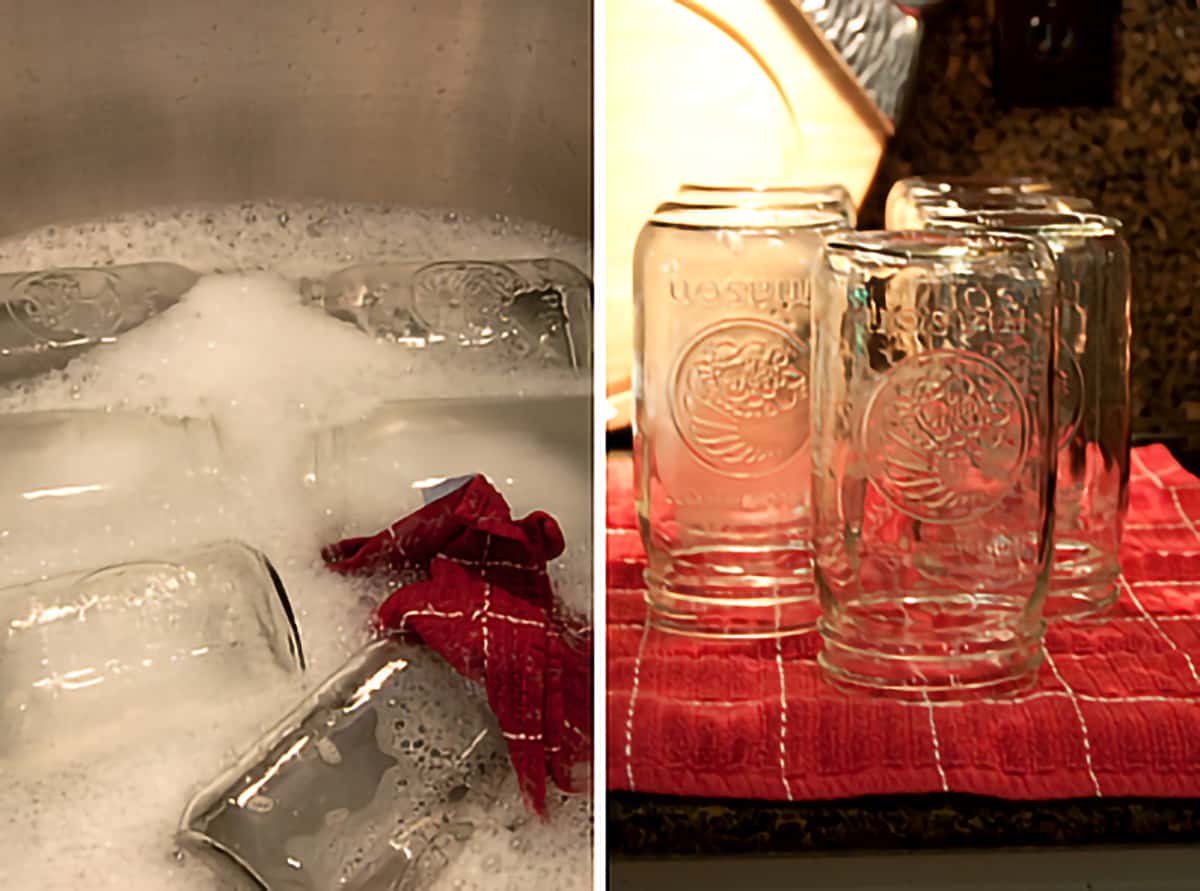
- My second step is to wash the jars in hot, soapy water. Rinse them well making sure all traces of soap are removed. Drain on a clean kitchen towel. After washing, the jars still need to be sterilized before filling them. See the paragraph below for my procedure.
👉 PRO TIP: I put the clean jars in the canner and let them heat up along with the water. Some people hold them in a 200 degree oven. The canner just works best for me.
You need the jars to be hot when you’re ready to fill them because putting hot food in a cold jar can cause breakage. Likewise, putting a cold jar of food into boiling water is just asking for broken jars and all your hard work to end up in the bottom of the canner.
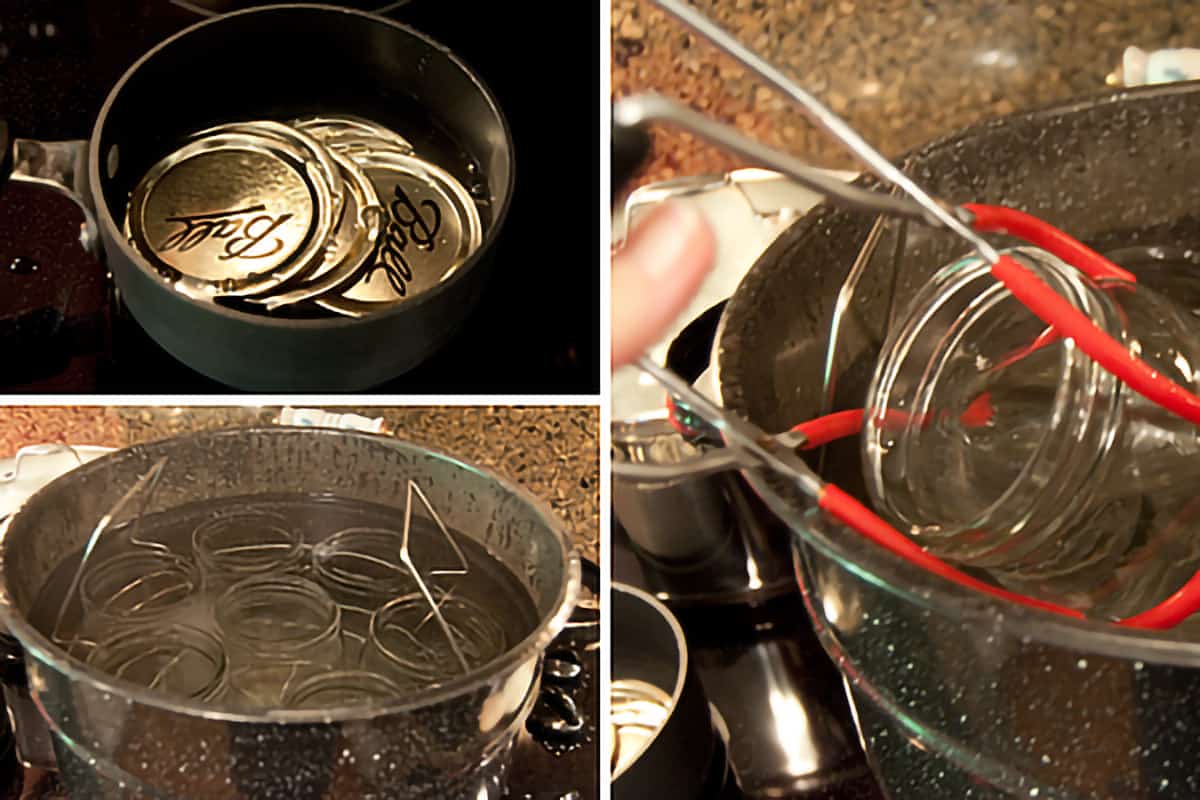
- Put the lids in a small pan with enough water to cover them. Set the pan on the stove with the lowest heat possible just to keep them warm until they’re needed. Set the rings aside.
⚠️ USE CAUTION! Remember you’re working with lots of boiling water when canning. Always use a jar lifter to remove jars from the hot water to prevent scalding.
- Ball wide mouth quart jar
- Ideal for preserving jams, jellies sauces, mustard & flavored vinegar
- Custom time tested ceiling compound help ensure a quality seal with each lid
- New brushed silver design on the outside lid matched kitchen designs
- Refrigerate up to 3 weeks, fresh preserve and store up to 1 year
Prepare the Produce
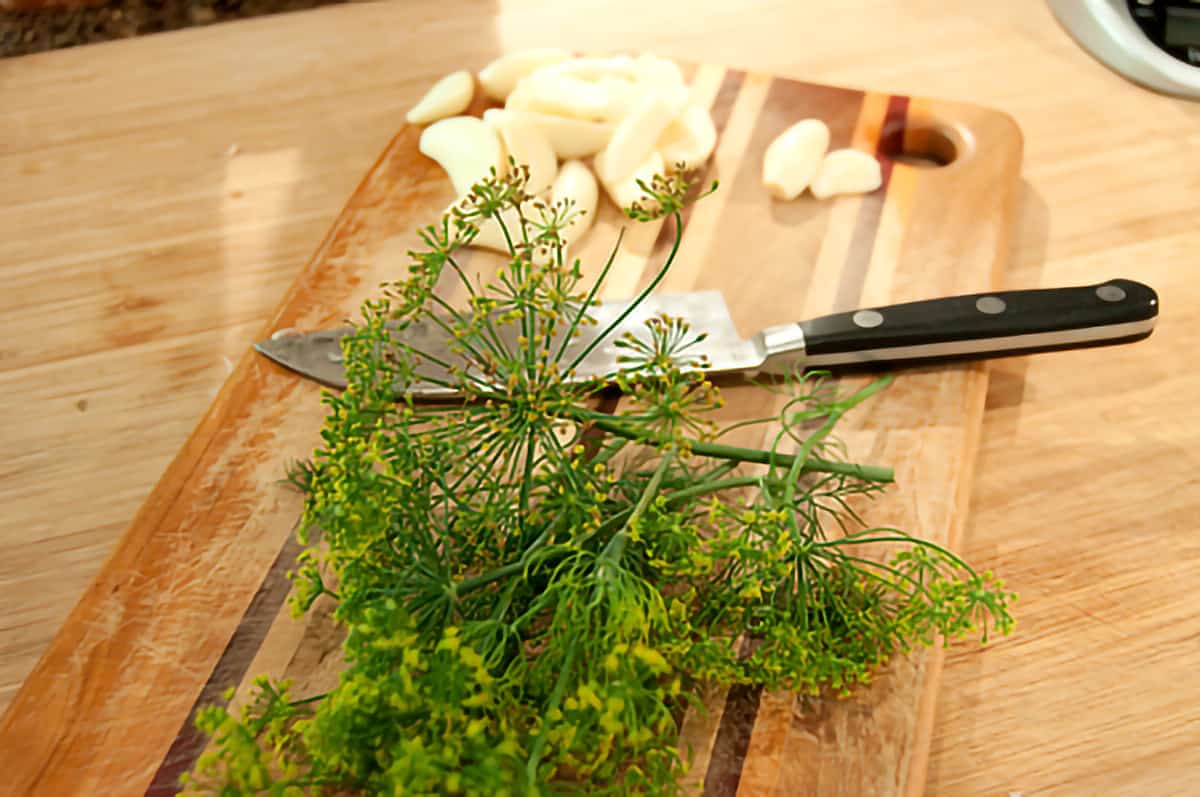
- Peel and halve the garlic. If you’re using fresh dill heads, trim them and set them aside with the garlic.
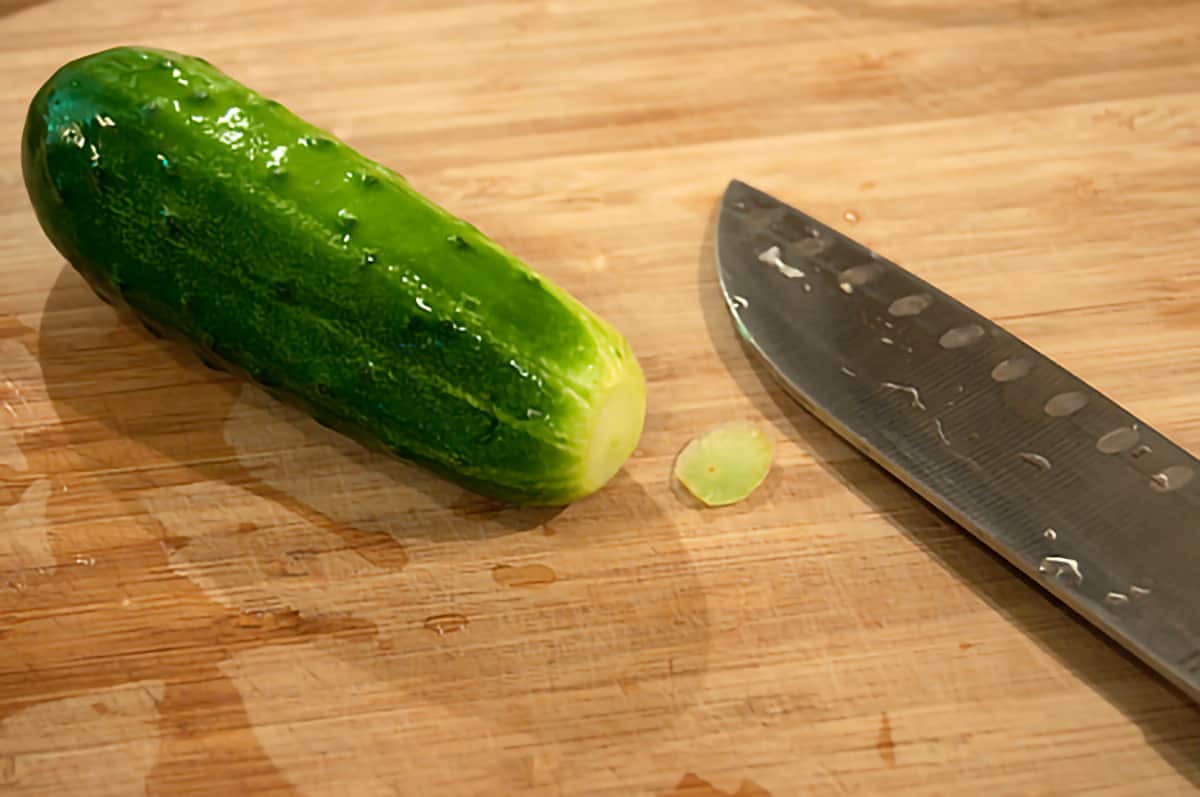
- Prepare the cucumbers by removing 1/16 inch from the blossom end of each. Cut into halves or quarters as you wish.
👉 PRO TIP: Why remove that tiny sliver from the end of the cucumbers? It’s because there’s an enzyme that remains in the blossom end of cucumbers which can cause your pickles to become soft while in storage.
Make the Brine
- For each quart jar of pickles, measure 1 cup water and 1 cup vinegar into a saucepan. Bring the water and vinegar to the boil. While the brine is coming to the boil, fill the jars (see next section).
Fill the Jars
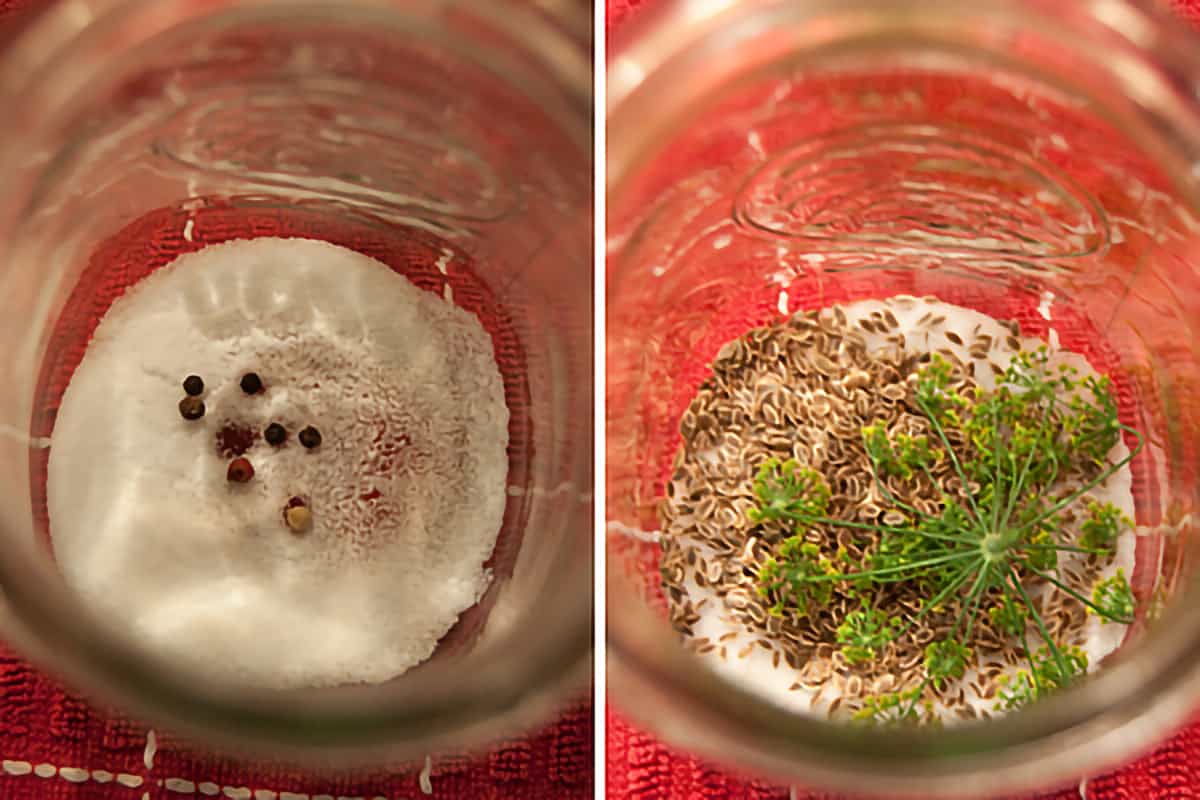
- In each quart jar place 1 tablespoon salt, 1 tablespoon dill seed (or 3 heads fresh dill), 6 black peppercorns, and 2 halved garlic cloves.
👉 PRO TIP: As noted earlier, each dill head counts as a teaspoon of dill seed. I only had a few heads this time so I used one head of dill and 2 teaspoons of seeds in each jar.
Add Cucumbers and Hot Brine to Jars
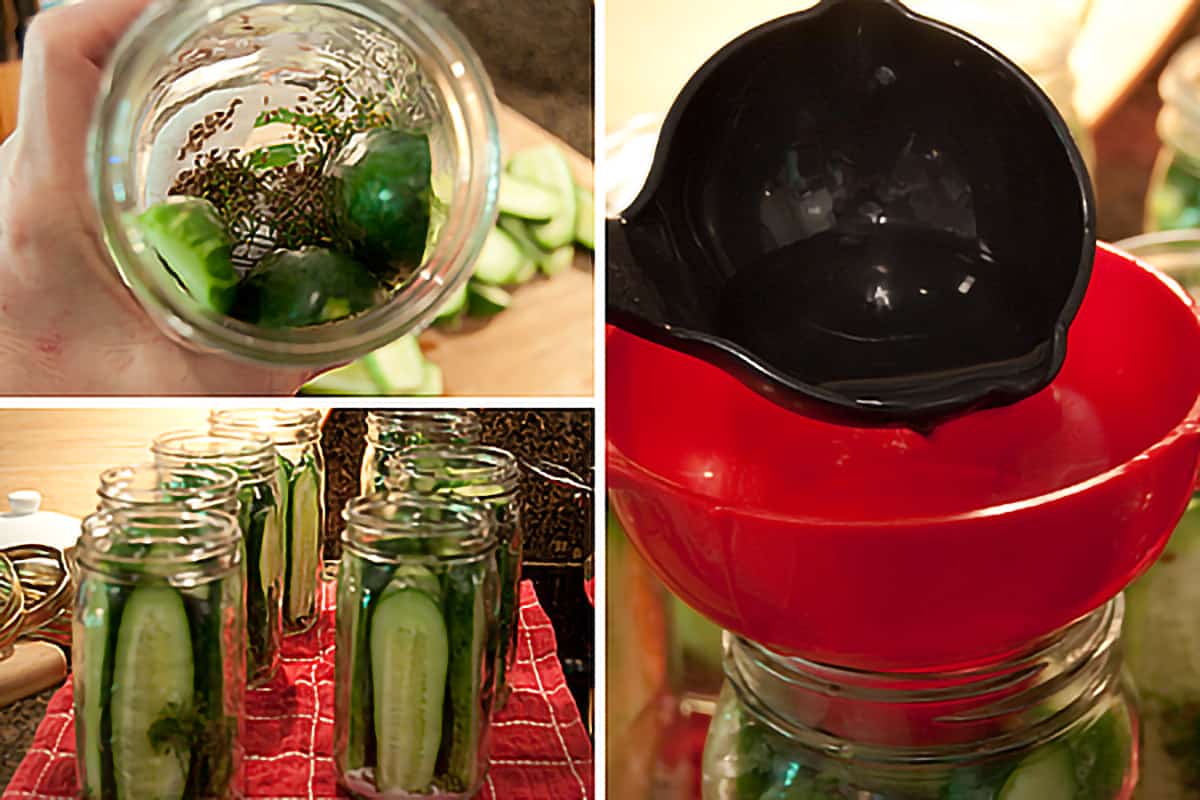
- Working with one jar at a time, pack the halved or quartered cucumbers into the hot jars.
- Using a canning funnel, pour the boiling vinegar and water solution over the jar contents leaving 1/2 inch of headspace.
🤔 What is Headspace?
When a canning recipe refers to headspace, it simply means the amount of space between the top of the liquid and the top edge of the jar.

- I realized just as I was about to put the lids and rings on that I had not included the garlic in the jars. Yikes! Just goes to show you that with this recipe it’s never too late to add an ingredient. You could even slip a hot red pepper in there at this point if you wanted to!
Clean the Jar Rims and Add the Lids
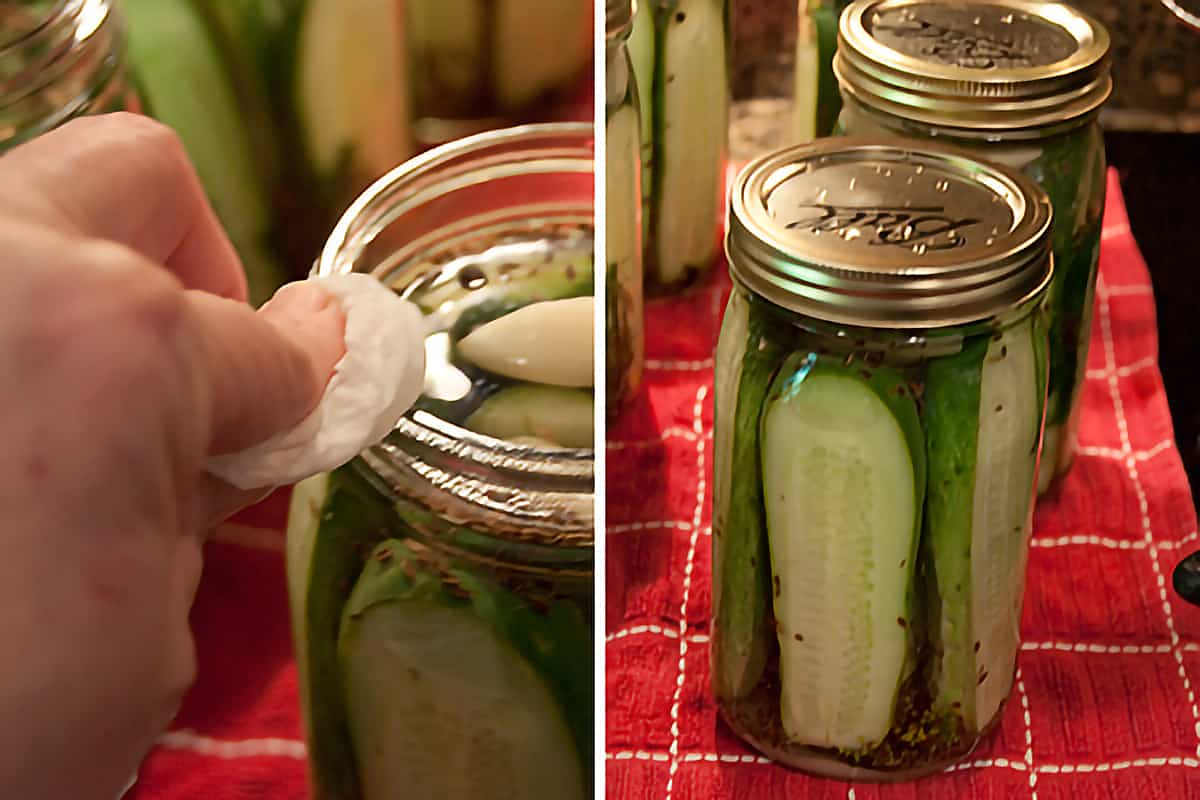
- Wipe the top rim of each jar carefully with a dampened paper towel. This is to make sure that there is nothing on there that would prevent the lid from forming a complete seal.
- Place the lids on top of the jars and screw on the rings (bands) until just finger tight.
👉 PRO TIP: When applying the rings to the jars, don’t screw them down tight or force them. The jars must be able to expel air during the canning process in order to create a seal.

🌡️ Process Using Low Temp Method
- Place the jars in the canner rack and lower them into the simmering hot water. There should be enough water to cover the tops of the jars by at least one inch.
- Place the cover on the pot. Bring the water up to between 180 and 185 degrees and process for 30 minutes (low temp pasteurization method).
❗Notes About Low Temp Pasteurization
I use the low temperature pasteurization method for these pickles. This method prevents overcooking the pickles and helps them to retain crispness during storage. The low temp method can only be used for high acid recipes and must be monitored carefully to make sure the water remains above 180 degrees for the entire processing time.
To use the low temp method, heat the water to a simmer while preparing the filled jars. Lower the jars into the simmering water and allow it to come up to between 180º to 185º F. Maintain the water temperature for 30 minutes. Check with a thermometer to be certain that the water temperature is at least 180ºF during the entire 30 minutes.
If the temperature of the water drops below 180 degrees during processing, bring the temperature back up to at least 180 degrees and start the timing over so that the jars have a full 30 minutes of processing at 180 degrees.
Note that there should be enough water in the canner to cover the tops of the jars by at least one inch. I keep a separate pot of simmering water on the stove in case I need more water in the canner when I add the jars.
❄️ Cool Jars and Test the Seal Before Storing
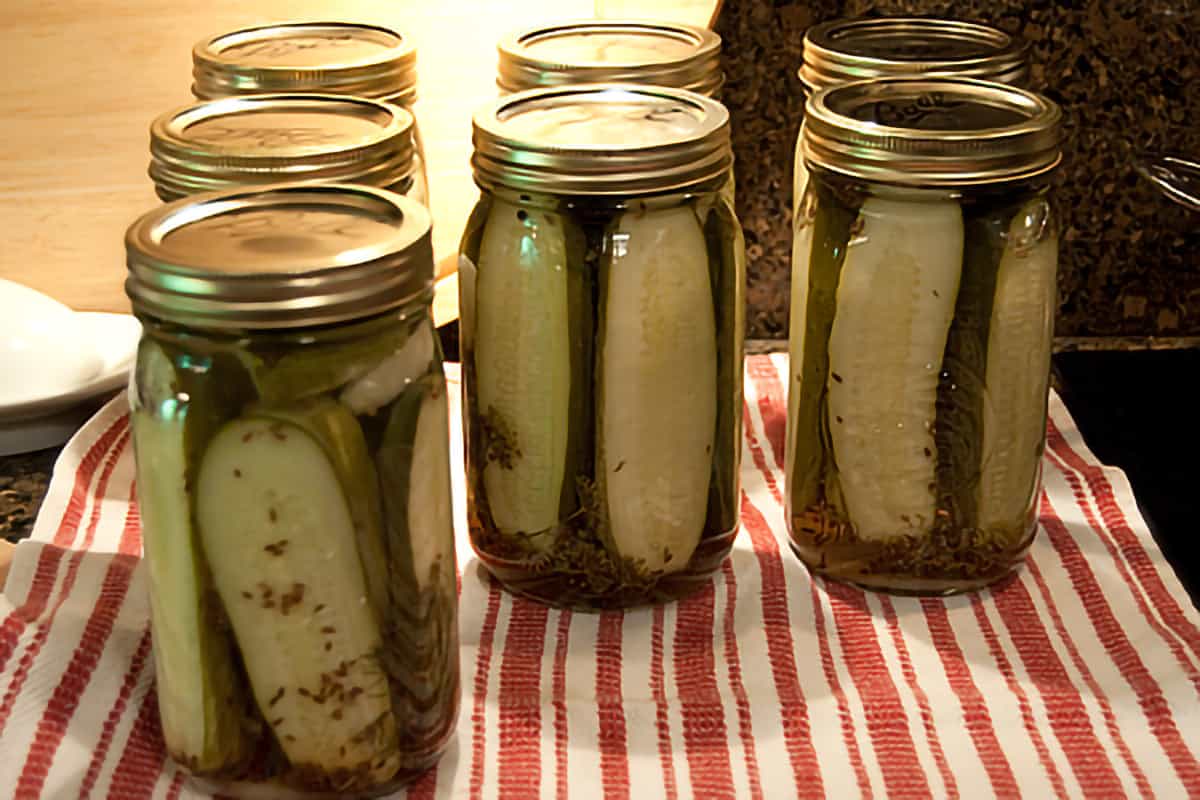
- At the end of the processing time, use a jar lifter to carefully remove the jars from the canner, place them on a clean dish towel, and allow them to cool completely (24 hours recommended).
- After jars are completely cooled, you may remove the ring bands. Be sure to test for a complete seal. Any jars that failed to seal are not shelf-stable but may be stored in the refrigerator.
❓ How to Test For a Complete Seal
- How to test the seal? First, gently press the center of each lid. If there is any movement then the jar did not seal. Next, gently pull upward trying to lift the jar by the edges of the lid. If the lid pulls away, obviously it didn’t seal. The pickles are still good, but can’t be stored outside of refrigeration.
You will notice when you remove the jars from the canner that the cucumbers have become a more olive color and there is undissolved salt in the bottom of the jar. That’s normal. By the time the jars have cooled overnight all the salt should have dissolved. If the salt still hasn’t dissolved after sitting overnight, gently turn the jar over a couple of times to mix and disperse.
And just like that, you have seven beautiful jars of Favorite Kosher Dill Pickles!
🍚 Storage Instructions
- Store the jars in a dark, cool place such as a pantry or cellar. I recommend six weeks of standing time for the flavors to fully develop. For best quality, the pickles should be used within one year.

Questions? I’m happy to help!
If you have more questions about the recipe, or if you’ve made it and would like to leave a comment, scroll down to leave your thoughts, questions, and/or rating!
Thanks so much for stopping by!
📖 Recipe
Want to save this recipe?
Enter your email below and get it sent straight to your inbox.
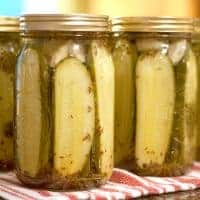
Favorite Kosher Dill Pickles
Ingredients
- 35 cucumbers pickling type (estimate 5 cucumbers per quart; more or less may be needed)
- 7 tablespoons pickling salt
- 7 cups white vinegar 5% acidity
- 7 cups water
- 7 tablespoons dill seed or 21 heads fresh dill
- 42 black peppercorns
- 14 garlic cloves peeled and halved
Instructions
- Prepare home canning jars and lids according to manufacturer’s directions.
- For each quart of pickles, bring 1 cup water and 1 cup vinegar to the boil.
- Meanwhile, in each jar place 1 tablespoon pickling salt, 1 tablespoon dill seed (or 3 heads fresh dill), 6 black peppercorns and 2 halved garlic cloves.
- Pack halved or quartered cucumbers into jars. Pour boiling vinegar and water over cucumbers in jars. Affix the lids and rings.
- Process in simmering hot water (180-185 degrees) for 30 minutes (low temp pasteurization method).
- Remove jars from canner and allow to cool completely (24 hours recommended). Remove bands and test for complete seal. Store in a dark, cool place.
- Recommend six weeks of standing time for flavors to fully develop.
Notes
- After the jars have cooled, be sure to test for a complete seal. See instructions in the post for testing the seal.
- After processing, the cucumbers will be a more olive color and there may be undissolved salt in the bottom of the jar. That’s normal. When the jars have cooled all the salt should be dissolved. If the salt still hasn’t dissolved after sitting overnight, gently turn the jar over a couple of times to mix and disperse.
- Store the jars in a dark, cool place.
- Allow six weeks of standing time for the flavors to fully develop.
- For best quality, the pickles should be used within one year.
Nutrition Information
Nutrition information is calculated by software based on the ingredients in each recipe. It is an estimate only and is provided for informational purposes. You should consult your healthcare provider or a registered dietitian if precise nutrition calculations are needed for health reasons.
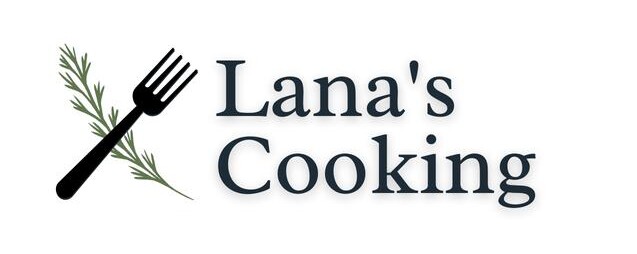
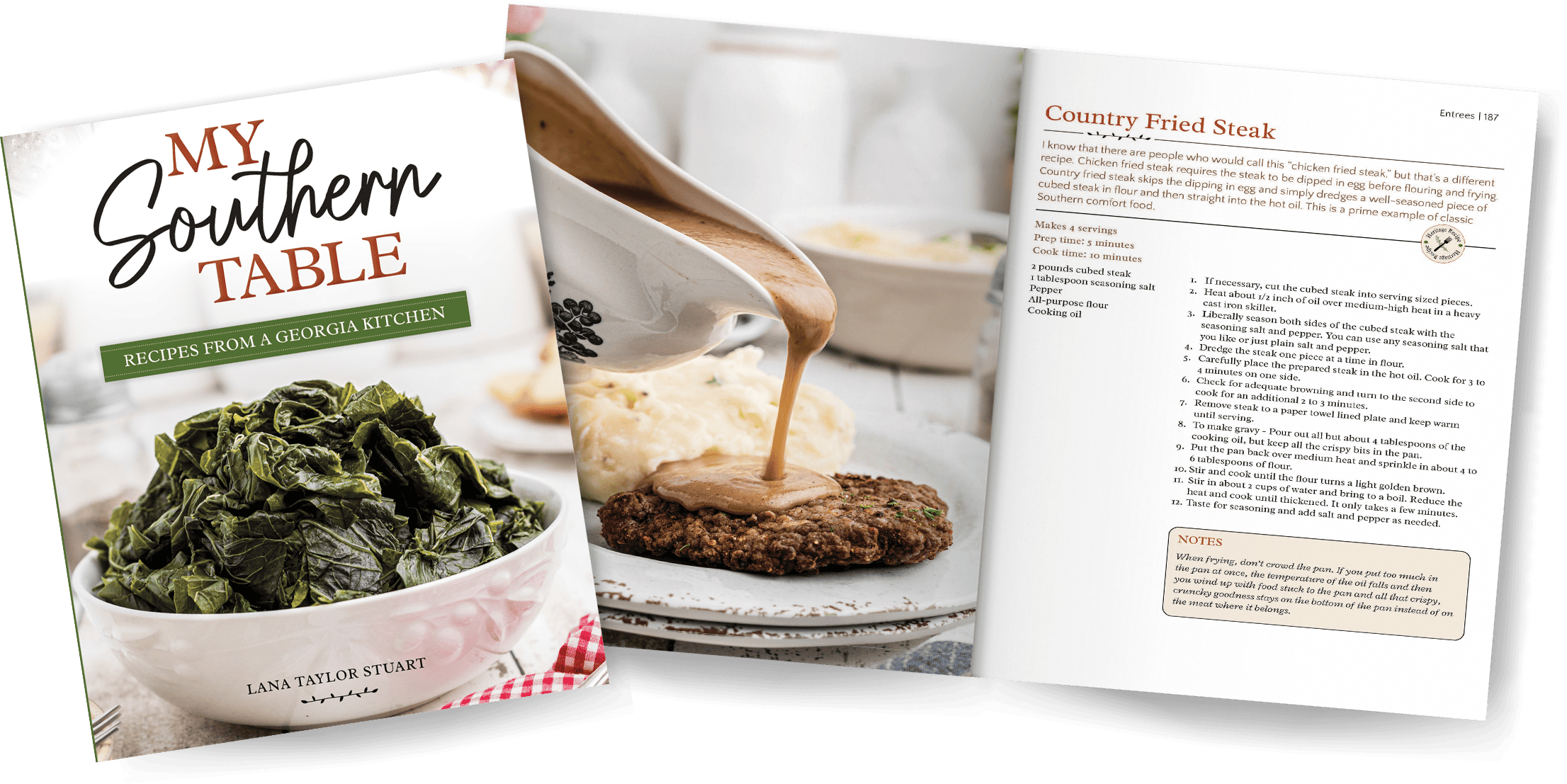
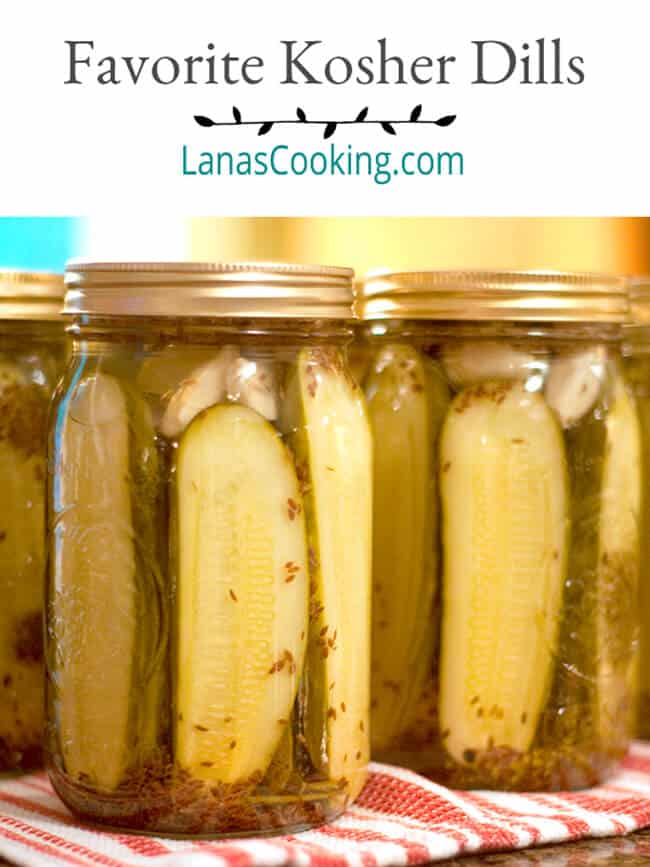
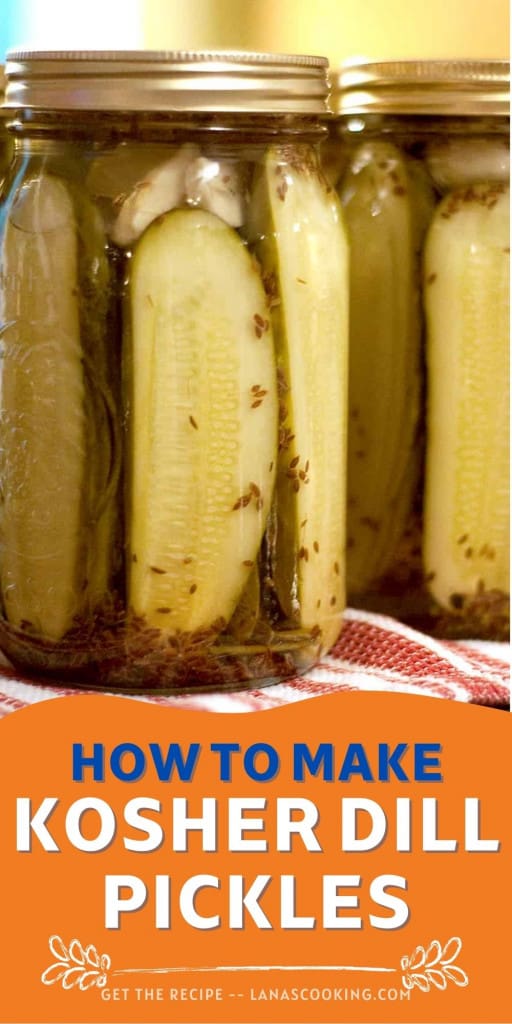
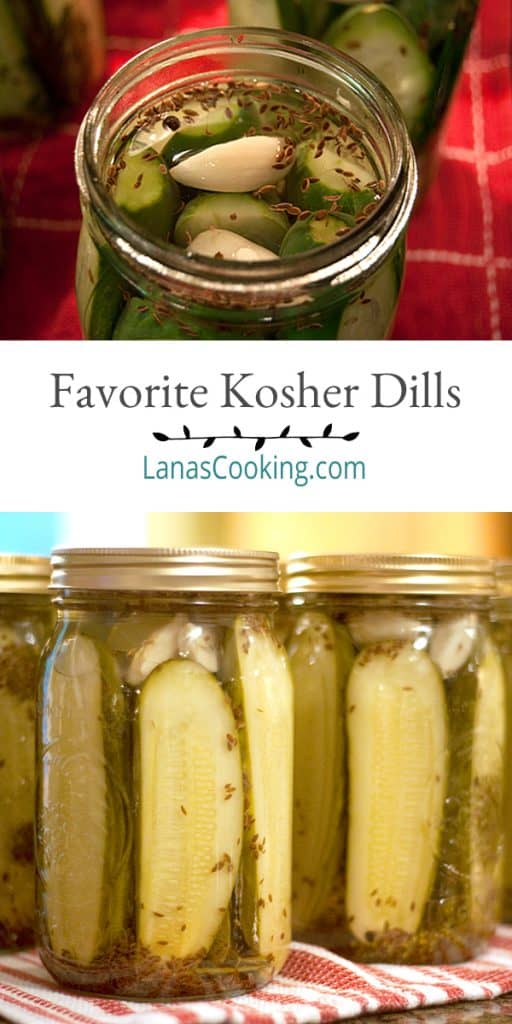


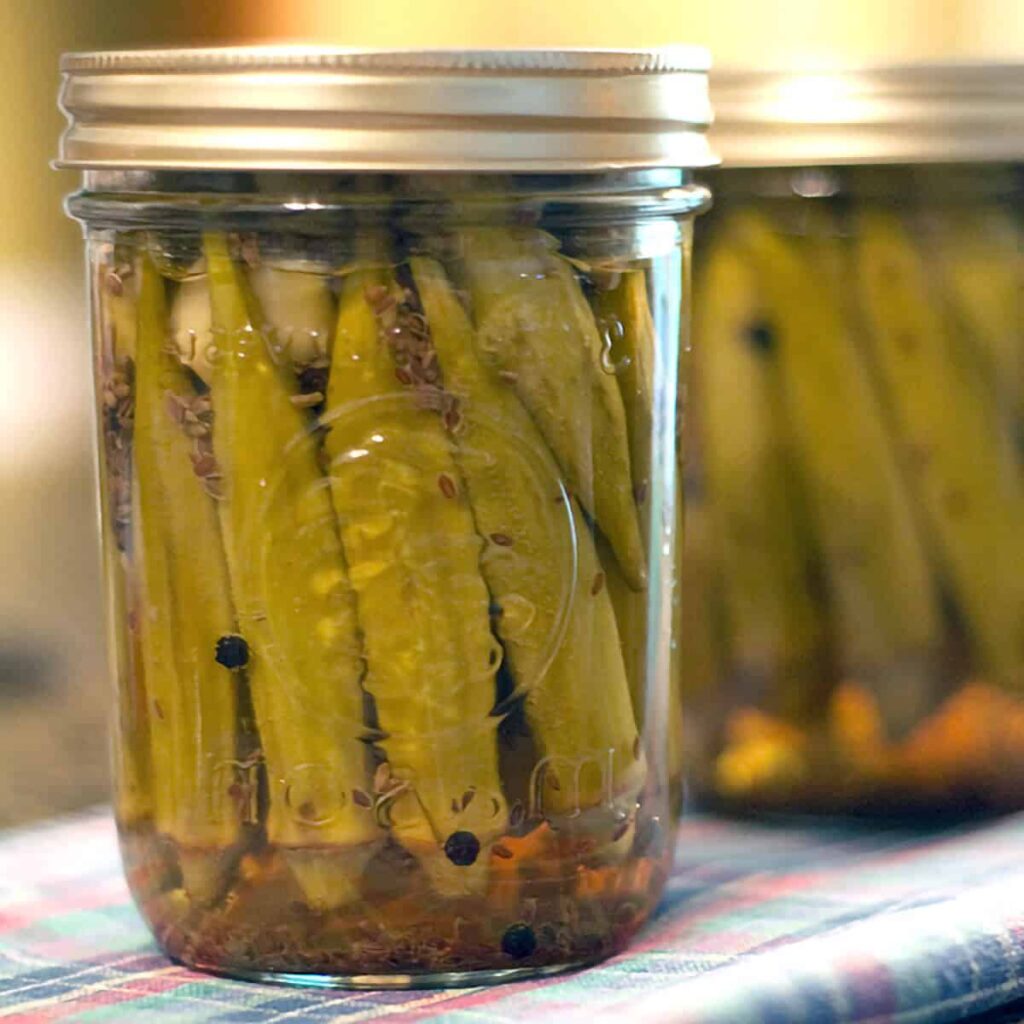
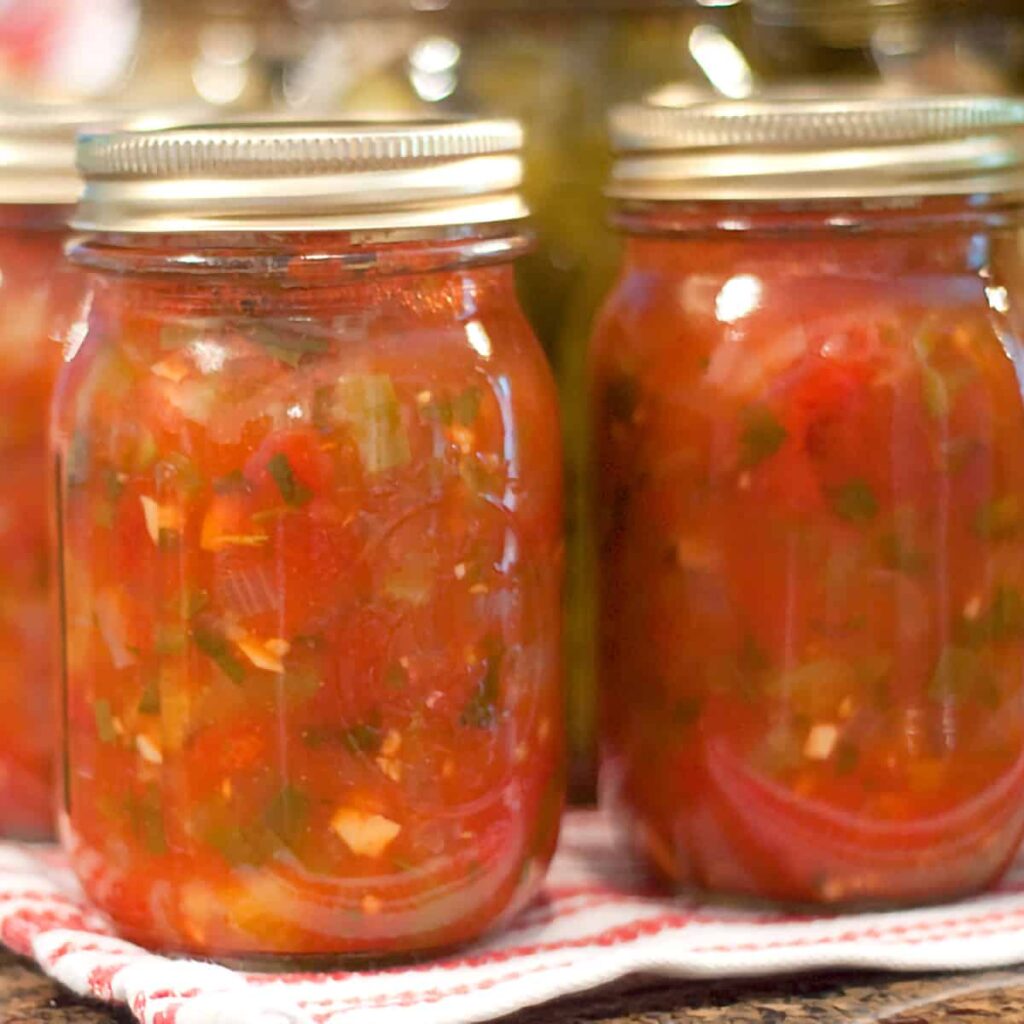
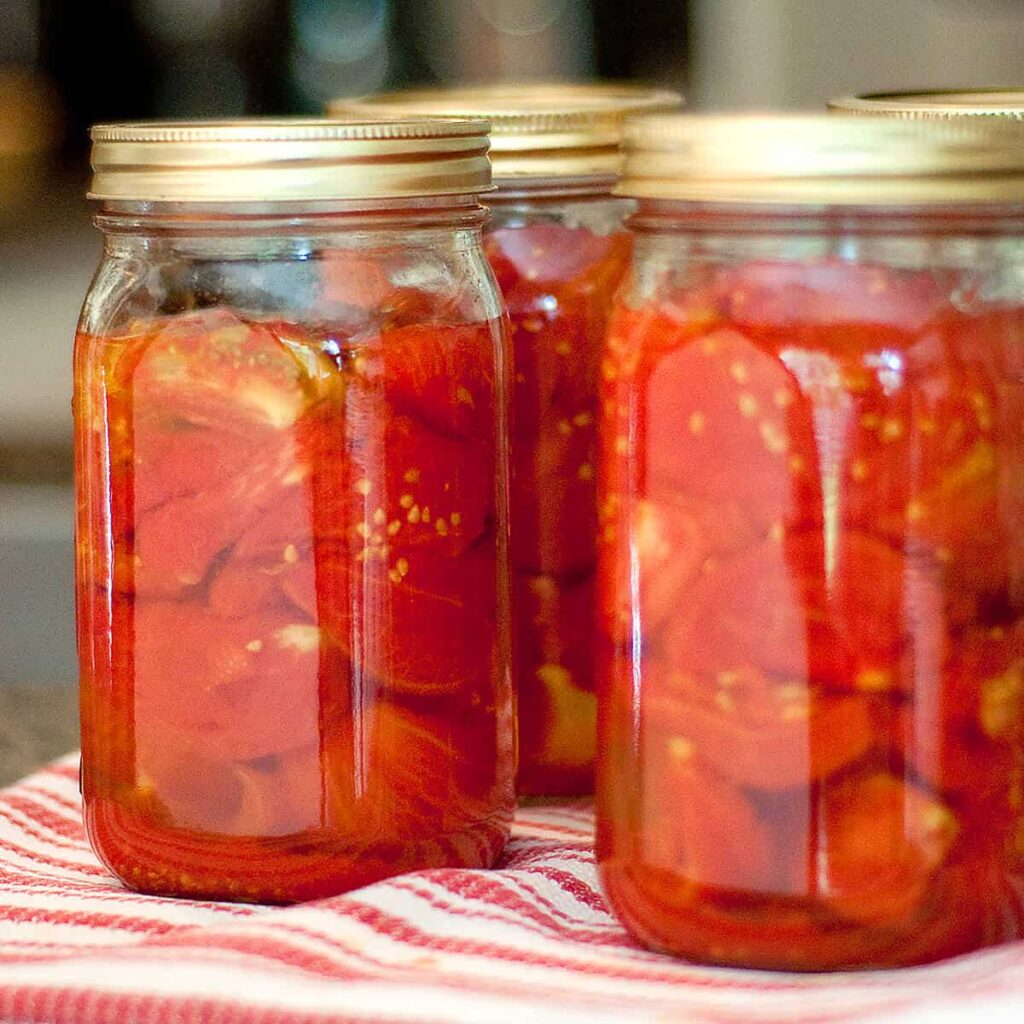
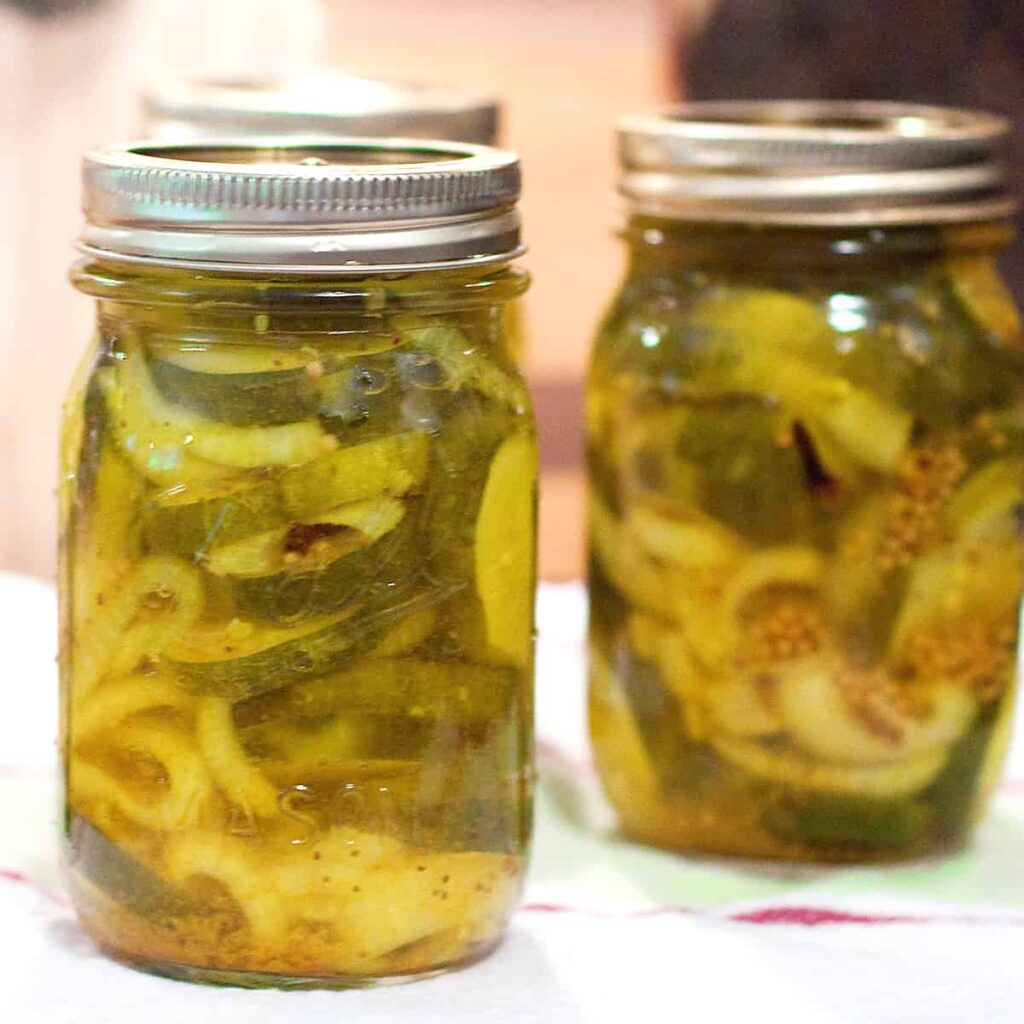
I made these pickles this summer and they are perfect . No better pickle out there . Thanks so much for this recipe . I will be sharing it
Thank you! And thanks for sharing.
Excellent recipe! Thanks. Only thing I did different was to heat the jars in my sous-vide. The water level was perfect and I set the temperature stayed at exactly 182. No worrying about the water temp.
Just made these today so I haven’t tasted them yet but was very glad to find a good recipe that does not use sugar! Trying the 180 degree bath instead of the full boil which really does soften pickles. I added 1/4 tsp of Pickle Crisp (Calcium chloride) to each quart which I have done with other recipes in the past. Have you ever tried this? If so, does it help with crispness in this recipe? CaCl is a form of salt so I don’t think of it as a chemical although technically it is.
I hope they turn out good for you. I don’t use “pickle crisp” or any other crisping agent in any of my pickle recipes.
Hi Lana, I’ve made the kosher dill recipe with halved cucumber and the recipe was easy to follow. I just made them a week ago so I haven’t tested a jar yet, but I can’t wait to try them!
Can I use the same recipe with sliced cucumber? My family is asking for sliced pickles for burgers and sandwiches.
Thank you,
Sarah Hinson
Hi Sarah – I haven’t tried this recipe with slices, but I’m sure it would work. If you try it, let me know how it works out.
Can I use apple cider vinegar?
You can if it’s at least 5% acidity. Be aware that it will definitely change the taste of the finished pickles.
Can I make pickle slices for hamburgers with this? If so, would I just do it all the same and slice smaller? I’ve never made pickles before!
I’ve never made kosher dill slices, but it should work. They’ll taste like kosher dills, though, not like the standard “hamburger dills.” If making slices, I’d suggest doing them in pints rather than quarts.
Hi, I’m a pickling beginner. Can I use this recipe to make just 1 qt of pickles? I don’t want to make 7 qts in case I mess up.
Yes, you can make as few as you like. You’ll simply need to reduce the ingredient amounts accordingly.
This was my first time canning kosher dill pickles, so I was a little nervous. I’m so glad I picked this recipe. This might be one of the best kosher dill pickles I’ve ever tasted! Thank you Lana…
That’s great to hear! I’m glad you like the pickles.
Hello Could this brine be used for refrigerator pickles
Possibly. I haven’t tried it for that.
What if I’m using pint jars does it still need that much in each jar?
I don’t have measurements or processing times for these pickles in pints. Theoretically, you could possibly use them by cutting your cucumbers to fit or using very small ones and making about half the pickling solution. However, the processing times for quarts and pints of any canned food is different and I do not have the correct time for these pickles in pints.
Hi, just canned your pickles for the first time yesterday, so excited to try them!!! I have two questions, some of the tips of the pickles are now sticking out of the liquid, is this okay or do they need to be refrigerated and eaten sooner? Also my garlic cloves now have picked up a blue hue, it’s this normal? I also had this happen in a refrigerator picked recipe I had tried.
Thanks so much!!
The pickles will be fine. They should still be covered with pickling liquid but it won’t affect their safety. About the garlic – that can happen sometimes if the garlic isn’t really fresh. There’s nothing wrong with it.
Hi Lana,
Made your recipe last year and the first batch went down in short order! Everyone loved them so I continued making them till there were no longer cucumbers available. The only thing I had a problem with is that I made pints…later a few quarts…so I had to half the ingredients to make it work. Our dill is more of a spring crop so I have to buy that but it is so worth it….makes the pickles look so pretty. It’s hard to wait for them to be ready especially when my grandkids love them.
Thank you for the best and easiest recipe! Btw, we grow our own garlic and I hate to see it ever go to waste which if often the case because we grow so much.
Pat
Pat – thanks for putting a smile on my face today! I’m very happy to know that your family enjoys the pickle recipe.
Thanks Lana this will be my first venture of dill pickling, I do pickled onions around Christmas time for my daughters and friends as it’s hard to find jarred pickled onions for some reason in Ontario, my only conclusion its very time consuming and probably not a lot of profit for companies, we always had a jar on the table when the girls were little and the supply just dried up, small specialty jars are available but expensive, anyway back to dill pickles, I missed the season last year but was determined to get organised this year, fortunately I found your site first time and was delighted to have all the information needed, thank you very much indeed regards Bill
I hope you enjoy the pickles, Bill! If you’re looking for other good pickling recipes, you’ll find lots at the National Center for Home Food Preservation website. They’re run by the University of Georgia and are experts in everything to do with preserving food.
Can you use minced garlic instead of the whole clove?
I’ve never tried that, but I don’t see why you couldn’t. I’m not sure why you’d want to take the extra step of mincing the garlic, though.
Hi Mandy. I do appreciate your feedback and will look into it. Would you mind letting me know how you were viewing the blog? Phone, tablet, computer…???
Used this recipe to make some pickles recently and they are the absolute BEST pickles I’ve ever had! Was a little too salty for me, so just made another batch with half the salt and we will see how that goes. I do have a question… Have you ever used this recipe to make relish? Would it work with that?? Would make some tasty relish!
Hi Kerri — I haven’t made relish using this recipe, but I have taken these pickles after they were made and chopped them finely to use as a relish. It was really good.
If you do pints instead of quarts does the recipe make 14 pints? Can you cut the recipe in half to only do 7 pints?
You can do pints if you like. You’ll have to cut your cucumbers down to fit the pint jars. You can make any amount you like. Half the recipe should make about 7 pints. Use half the salt, dill, etc. per jar for pints. How many jars you get just depends on the size of your cucumbers.
Hi Lana: Do you leave the garlic in the jars? Joy of Cooking says to heat with the brine then remove garlic cloves as they create bacteria. I’m confused lol
Raw garlic can be very dangerous when stored in oil at room temperature. The garlic in this recipe is neutralized by the acidity in the vinegar. However, you can certainly remove it if you’d like. I leave it in.
Thank you very much. I’ll leave it in
Can you do pickle chips instead of pickles cut the long way for this recipe? We use the chips in our house and I was curious before I made them. Thanks!
I’ve never made them that way, but I feel sure you could.
I need to find out how I can can 6 pints of dill pickles. Need help
You can them exactly the same way and for the same time as in this recipe. Just use the pint jars in place of quarts. You may have to select smaller cucumbers or cut down larger ones to fit.
Tried these last summer. Best dills ever! All my grandkids love them so they are definitely a redo each year. They are a bit salty for my taste but the kids say don’t change a thing! Thanks for a great recipe. ❤️❤️❤️
My grandkids love these, too! By the way, you can reduce the salt in these pickles without affecting the pH. There’s so much vinegar that they will still be safe for canning with half the amount of salt.
Question- is that much salt needed to keep them shelf stable or is it for taste? Trying to figure if I can lower the salt a bit. Thanks!
It’s for taste. You can safely reduce the amount of salt. In this recipe, the vinegar’s acidity keeps the product shelf stable.
About to try your recipe. Query: You indicated you should cut the ends of the cucumbers off so they would not become soft. I actually prefer soft, but not mushy. If I do not cut the two ends off, will I end up with soft or too mushy to eat?
Thanks
I can’t say, Glen, since I always cut that little sliver off when making pickles. Always have. but I wouldn’t think they’d become too mushy to eat.
Thanks. Follow up query. Should the jars be fully submerged during the boiling process, or can the water level stop just below the top of the jars?
The tops of the jars should be covered by at least 1-inch of water. The water level cannot be below the tops of the jars.
I am always afraid to use quart jars in my canner because recipes say to have an inch or two of water on top of the jars. I have a large canner but if I fill that full when it boils it will boil over. Yours looks like it has hardly any water on top of the jars. Just wondering…
My canner is deep enough to have just an inch of water over the tops of the jars. Getting the depth of water just right is definitely a balancing act that comes with experience. This is a low temp process recipe so the water won’t be boiling.
my old pickle recipe that I use is the same as yours except it calls for mustard seed instead of peppercorns. What is the difference in taste, better or not?
I haven’t made this recipe with mustard seed so I can’t say whether that would be better.
Hi Lana!
This was my first year growing cucumbers, so of course I had to pickle some! I’ve made refrigerator pickles that have been delicious but I wanted to try actually canning some. My question is can I use pickling spices, mostly because I already have them on hand.
Well, sure, you can use pickling spices if you want to, but your pickles will not taste the same and they won’t be “kosher dills.” Commercial pickling spices (like McCormick, etc) usually contain cinnamon, allspice, mustard seed, coriander, bay leaves, ginger, clove, red pepper, black pepper, cardamom, and mace. That’s a very different flavor profile from this recipe which uses only dill, black pepper, salt, and garlic for flavorings.
Thank you Lana! We decided to follow the recipe as is since we already have pickles made with pickling spice. We are making this recipe today. So excited to try them! One question, if we happen to have any jars that don’t seal and need to put them in the refrigerator, is the wait to eat time the same as the jarred one, 6 weeks. Just checking for the hubs cause I know he’ll ask as he LOVES pickles!! LOL
For full flavor you should wait. However, they’re still pretty tasty even when fresh. It’s up to you.
Hi Lana,
I want to try this recipe but could not find a water bath canner anywhere and ended up getting a Fruitsaver brand steam canner. Do you know how this recipe could be transferred to that application? Especially times and if the jars would have to be sterilized? TIA!
Sina
Sorry, but I’ve never used a steam canner. I know there’s some information about them on the NCHFP web site that you might find useful: https://nchfp.uga.edu/publications/nchfp/factsheets/steam_canners.html
Thank you! I went ahead and tried it after doing some research but before seeing your reply. Fingers crossed! They sound and look amazing!
Good morning! Thanks so much for this recipe, it was referred to me by a friend. She’s a novice as I’m a very green beginner!
I’ve seen recipes that add onions and for an onion lover, it sounds good.
What are your thoughts?
Thanks again!
Unless you are a very experienced canner, I would not recommend altering a canning recipe. You may be interested in reading this blog post on that subject. Also, the ultimate guide to canning is the USDA Complete Guide to Home Canning and it explains in detail how to maintain the safety of home canned foods. The USDA Guide or the Ball Blue Book will give you a really good introduction to home canning.
The recipe was not enough brine for my quart sized jars
That would usually indicate that the jars were not packed with enough cucumbers and too much empty space was left for the brine to fill. I always have some brine left over.
Was having a bad day, still had pickles to can and thought I’d added everything to the jars until this morning!!! I have 8 quarts of pickles with NO added pickling salt…. For some strange reason, I did not add the salt. Are these pickles now trash or omitting the salt is no big deal?
The pickles are still safe to eat assuming you followed correct canning procedures. They certainly won’t taste the same. But, no, they’re not trash :-)
So glad to hear that!! I’ve canned a large amount of pickles from this recipe and followed the recipe exactly but had too much on my plate yesterday. Still waiting for the 6 weeks to enjoy them.
These are THE BEST pickles I’ve ever made. We’ve been searching for a recipe that tasted like my Nana’s and we’ve finally found it! They stay so crunchy and the flavor is incredible.
I’m so glad you like the pickles, Kayla! Our family does, too.
Hi. Can I use apple cider vinegar 5% instead of white vinegar? Thank you.
Hi Cristina. Yes, you can as long as it is at least 5% acidity. It will, however, change the taste and appearance of your pickles. They’ll have a “mellower” taste and the apple cider vinegar will probably darken the pickles as well.
Thank you for the answer. I have a couple more questions, if you can please help me.
I used the ratios in your recipe, but instead of white vinegar I used apple cider vinegar 5%, and also added 1/2 tablespoon of sugar per 1 cup of water and 1 cup of vinegar (used salt, too: 1 tablespoon pickling salt per 1 cup of water and 1 cup vinegar). Questions:
1) Is it ok to use sugar like I have written above?
2) When I added the brine ingredients in the pot on the stove to boil, I did not mix the ingredients (manually with a spoon). Does the boiling process mix the brine ingredients uniformly? I just want to make sure that everything got distributed uniformly in the brine so that in each jar there is a correct ratio of water/vinegar/salt/sugar.
Thank you.
Hi Cristina – First, yes, your ingredients are thoroughly mixed if they’ve dissolved and come to the boil.
Second, about the added sugar — I’d be wary of doing that unless I was going to store the product in the fridge (in which case the boiling water sealing process wouldn’t even be necessary). Home canning recipes have to be within a specific pH range in order to be shelf-stable and avoid the possibility of developing botulism. In this case, the vinegar to water ratio is likely high enough that the small amount of sugar you added wouldn’t affect the outcome very much, but I can’t possibly know that without lab testing. Also, the NCHP says “it is possible to affect the safety of a home-canned good by using too much sugar. Sugar is, after all, a carbohydrate, and carbs impact the density of foods. Extra sugar also slows down heat penetration.” Now, again, the amount of sugar you added is probably not enough to cause problems, but canning recipes are written very specifically for a reason. They absolutely have to be safe from a pH standpoint and correctly sealed in order to be stored outside of refrigeration.
If I’d made the pickles the way you describe, I’d store them in the refrigerator just to be certain of safety. I can’t imagine why you’d want to add sugar to dill pickles, anyway :-)
Thank you for the quick reply.
I added the sugar as a taste preference, and I did put the jars in the fridge after about 24 hrs after canning them. I also saw this recipe on the NCHFP website https://nchfp.uga.edu/how/can_06/quick_dill_pickles.html, and it uses sugar, but less vinegar than water. What do you think in terms of ph and safety, especially since I used more vinegar
If the recipe was on the NCHP website you can be absolutely sure that it has been tested and proven safe for home canning and pantry storage. They’re recognized nationwide as the highest authority in home canning.
My dad always added a pinch of alum. He said this kept the pickles crispy. Any thoughts?
According to the USDA’s latest research, alum may be used to firm fermented pickles, but has little crispness effect on quick-process pickles like these.
Hi! Quick question, did you reduce the amount of salt? I thought I remembered adding one tablespoon and one teaspoon of salt per quart jar in previous years, but i could be loding it. Love your pickle recipe, been using it for years!
Wow, you have a great eye Tave. Yes, you’re right. I did decrease the amount of salt after many people complained that the pickles were way too salty. I still use the original measurements when I make them, anyway.
Thank you!!
I am wanting to slice my cucumbers into bite size pieces. I usually use a mandolin and cut them about 1/4 inch or so. Would this recipe still work for this?
I’ve never made this recipe with slices, only with whole cucumbers, halves, or spears. However, I believe you probably could do slices.
I’m so ready to make my own dills at home – been buying them from the store for ages and I think that I would save so much money if I just made them on my own. Thank you for your guidance and recipe – can’t wait to try it!
Thanks for this recipe. I thought I bought three Japanese cucumber plants, but actually bought three containers with three plants in each! Needless to say, I’ve got bags full.
Surprising it took me a lot of searching to find your recipe, which didn’t use sugar. All the recipes I found before yours all had cups of it.
My only question: other recipes I saw had higher ratios of vinegar to water. In a 1:1 ratio, doesn’t the acidity of the vinegar get compromised?
Thanks for your time.
Thanks for asking, Kelley. The ratio of water to vinegar is 1:1 which is standard for most dill pickle recipes. That ratio will maintain the necessary acidity for shelf-stable pickles so long as the processing instructions are followed correctly.
Lana,
Just wanted to say thanks. This is the third year we are coming back to your recipe for “our” dill pickle recipe. They are fantastic every time. Thanks!
I’m so glad to know that you enjoy this recipe! It has been my go-to for years. I have the dill growing for it in the garden already :-)
These just came out of the canner:) they sure look nice!!! I am very excited to see how they turn out!!! (In 6 weeks)
These pickles have been a hit in my house! We’ve made them twice this summer. My husband woke me up one night to tell me how good they were, ha! Thanks for this recipe!
I’m so pleased that you and your family are enjoying them!
I am so happy that I found your website. I have been using your receipt ever since last year. Those pickles are “THE BOMB.” I really enjoy making them and I can’t keep enough of them on hand between friends and family. Looks like I will be growing pickles year. THANKS!
hi, im so happy i found your sight! this is our first year doing a garden, and im starting to harvest some of our veggies now…we have alot of pickling cucumber and english cuc’s that we planted…my daughter and i have just finished our official first batch of pickles! can hardly wait to see how they taste! i so love the “sour” type of pickles and im hopefull this recipe will do it…thanks so much
These look beautiful! Do you use white vinegar or apple cider-or does it matter?
Hi Lana,
I read through this recipe and thought it sounded great. I’ve canned my own pickles before but not for a couple of years now and couldn’t find my recipe. I loved the ease of yours but have to say that the pickles came out extremely SOUR. I followed directions to a “T” and used good quality Heinz vinegar with the proper acidity. I don’t understand why they came out so terribly sour. The cukes were small to med, fresh and of good quality. After opening the first jar I now need to put a teaspoon of sugar into the opened jar and let them set in the fridge for a day or so before we can eat them. That seems to help cut the sourness. Any idea of what happened?
Deb – I’m really sorry the pickles didn’t turn out like you expected. This is our family’s favorite kosher dill recipe that I’ve been making for at least 15 years. It’s really hard to say what happened without having been there. But I do know that different varieties of cucumber will give you a different taste and texture in the finished pickles.
Just a curiosity…. What makes these pickles KOSHER? Is there a difference between dill pickles and Kosher dill Pickles? Perhaps the process? the ingredients? the flavor???? I would appreciate any education you can give me.
Erik – Kosher just means that garlic is added to the pickling mixture. It has nothing to do with Jewish dietary law and shouldn’t be confused with food prepared in the kosher manner.
this is the 2nd year in a row that I’m using this recipe for the cucumbers I grew, and as I was checking it to start a batch today, I thought I should take a moment to thank you for sharing it. they’re delicious & so simple to make- we’re never buying pickles again! :)
You’re welcome, Amy! It really pleases me to know that your family enjoys these as much as mine does.
I have read where you need to soak cucumbers in cold water for 4-5 hours before canning them to keep them crisp…is this true? If so do you soak them whole and then cut them afterwards? Thank you…looking forward to trying these this week!
Kim, some recipes do call for letting the cucumbers stand covered by ice before processing. The recipe I recently posted for Bread and Butter pickles does. I’ve never seen that it made much of a difference myself.
I am a novice to pickling so I wanted to begin with refrigerated pickles. Can the kisher pickle recipe be used for refrigeration?
What are the differences between canned and refrigerated, except for shelf life?
Scott, you can use this recipe to make refrigerator pickles if you want to. You just don’t do the canning steps and the pickles must be stored in the refrigerator. The canning process seals the jars and makes the product shelf stable without refrigeration. You refrigerator pickles will actually be crisper because they won’t have been heated for as long.
I just made these and they are great but my palate is sensitive to salt, can I adjust the salt in the recipe?
Yes, of course! Feel free to adjust the salt to suit your tastes. It doesn’t act as a preservative in this recipe, only for flavoring.
I will add just a tablespoon of salt to each jar in the recipe. I did add a small sprig of dill to each jar as well. They really are delicious! Thanks!
It shouldn’t matter if I use 14 pint jars instead of 7 quarts right? I bought everything needed and then as I went to make I realized it said quart and I only have pint jars right now :(
You can use pints, but will need to adjust. You may need to cut your cucumbers to fit the jars. Use half the amounts of salt, garlic, dill, etc. per jar for pints vs. quarts. You’ll also need to adjust the processing time for pints rather than quarts. Processing for pints is: 10 minutes at 0-1,000 ft altitude, 15 minutes for 1,001-6,000 ft altitude, and 20 minutes above 6,000 ft altitude.
Wondering if you have to boil the jars for the refrigerator pickles….and can you use Kosher coarse salt? Thanks, Bonibelle
Bonibelle – For refrigerator storage, you don’t have to boil to the jars but I think it’s a good idea if you’re going to be storing them for more than a couple of days. And, yes, you can use Kosher salt in these.
Oh my, these look perfect!
Thank you for these very easy to follow instructions. I made my first batch of pickles tonight and followed your recipe. Thank you so much! It was so easy.
Thanks for mentioning cutting off the blossom end of the cucumber. I didn’t realize it contained an enzyme that could make the pickles soften. I’ve never had any problems getting crisp pickles until last year. I didn’t actually cut off the ends, but “scrubbed” them off while washing. Last year, I had family members “helping” and I didn’t specifically mention cutting or scrubbing the ends . . . soft pickles for the first time!
I have been in the habit of using distilled water as we used to have well water and I was warned that water, whether private well or chlorinated tap water, can effect the final product. I’m not sure this is true, I just never wanted to take a chance!
if you don’t have seed heads, dill seed works best. I got it online in bulk.
Yes, I purchase dill seed online from Penzey’s. They have great service and wonderful products.
I was just wondering if you would know whether fresh dill could be substituted for the dill seed or dill heads? Thanks!
Sure. I can’t give you an exact amount, though. You’ll have to use your own judgment.
Thanks for the lesson in canning pickles. I only like half sour pickles and pickled asparagus and green beans. I’ve tried pickling watermelon rind unsuccessfully – no one liked it. I’ve also made quick pickled onions with some success. I am going to ACE next weekend and buying the 2 gadgets I need to do canning. Thanks alot.
You’re welcome! If you’re new to canning, the best thing you can purchase is a copy of the Ball Blue Book. It gives step-by-step instructions and has lots of recipes, too.
Hi! I stopped over from One Perfect Bite, you have a beautiful tutorial here! I do some canning, and will copy your recipe for next time. We’ve had an unusually dry, hot summer here in Philly and my cukes did not do so well-but there’s always next year:@)
I just made these a few days ago. First of all, your recipe and pictures are so helpful! This was my first time canning alone and it was easy. These pickles are so gorgeous my husband couldn’t wait the 6 weeks to try them. He has stated that we are never buying store bought pickles again! Thank you for a fabulous recipe—I look forward to trying more!
I am going to learn to can just so I can make these! I am so excited – I have several people to teach me! THese look so delicious – thanks for sharing your secrets!
I am watching my cucumbers to turn into pickles. Thank you for sharing this recipe. -Tien
The great pics and thorough explanations almost make me feel brave enough to try canning myself. GREG
Greg, If I can do it anyone can! Although I have been canning for a long time (about 35 years) it is not so intimidating as you might think. Start with something very simple, like strawberry jam, to get an understanding of the basics. Purchase a Ball Blue Book and follow its instructions carefully and you’ll be canning in no time!
these look and sound just perfect, I can see why they are a favorite… I cannot find good cucumbers for pickling around these parts, gonna have to find a source further away I guess as I am itching to put up all kinds of pickles – do the squash, okra and green beans along with relishes, but no cukes….
Hi Drick. I got my cucumbers at the farmers market. They actually came from North Carolina but there are lots to be found around here. Hope you come up with some soon! I haven’t done my okra pickles yet. I’m waiting for an order of dill seeds from Penzey’s. Used up all I had stored from last year’s dill harvest. That’s one thing that I can’t find around here!
for clarification…..regular cucumbers or the ‘kirby’ type? many thanks…this post has my mouth watering! btw, if I do make them i have no idea how im going to keep my paws off for 6 weeks. isnt that considered cruel and unusual punishment??
clive – These are the kirby-type cucumbers. They usually labeled “pickling cucumbers” in the market. They’re the best for making pickles.
My daughter agrees with you that it’s cruel to have to wait six weeks. But, for good flavor, you do need to wait. I usually make them and don’t tell her I did them until weeks later :-)
Mmmm! I have another type of jarred pickles bookmarked right now, but these might be even better. They’re so beautiful-looking too! Great gift idea :)
They do make great gifts if you can manage to keep from eating them all first!
Mmm they look so good! Reminds me of the pickles I used to make for the 4-H fair when I was a little girl!
Once after hubby and I first married (17 years ago) I got into my head I wanted to make rasberry jam. I bought everything and read up on it, and made that jam. It was definitely a project, but I really enjoyed doing it. I’ve never canned anything since then. Why?
Back then, the directions I had for the jam had me use the wax on the tops. I don’t see that much anymore. Is it something only used for certain foods, or just a process only some people choose to use.
BTW, I have a ton of Ball canning jars that I use for storage, mixing marinades and dressings, etc. I love canning jars.
Hi Pam – The wax seal, like the inversion method, is an old technique that is not recommended any longer. The wax seals just didn’t hold well. The wax tended to shrink away from the sides of the jars letting bacteria and who knows what into the product. All jams and jellies should be processed using modern lids and rings.
That explains why I haven’t seen anyone using it. Like I said it was 17 years ago…and now I feel old. LOL
I may have to try my hand at canning again. Now I wish I grew some pickling cucumbers.
this recipe sounds a lot like one that a friend gave me – she got it from a friend 40 years ago. One difference is that my recipe calls for a dried chile in each jar. It adds a wonderful subtle smoky heat to the pickles.
Trish – You can add a chili to the jar if you like. You’re right – it adds a nice little smoky heat to the pickles.
These look delicious! I’m still eating last year’s cukes and just starting to pick this year’s. Thanks for sharing your recipe!
I LOVE you for posting this! I’ve just canned for the first time, as you know, with my cherry pie filling. :) I have always wanted to make pickles, and my daughter is obsessed with these jars of Dilly Beans (green beans) at the grocery store. I refuse to buy them because they are almost $8 a jar! :-O So I’ve been wanting to make both.
I do have a question, as I noticed this with the cherry pie filling recipe too. I noticed that your instructions say to remove the bands after they’ve cooled overnight. Why do the bands need to be removed?
Hi Amanda! You don’t *have* to remove the bands but it’s recommended by most canners for two reasons. If you leave the bands on you can’t see as easily if a jar has lost its seal during storage. And, second, if you live in a humid climate the bands have a tendency to rust. If you leave them on and they rust it’s difficult to open your jar later on. If you remove them, dry them well and store them, they can be reused over and over for years!
Honestly, a lot of times I don’t remove the bands. I think the jars look “naked” without them :-)
BTW – I have a great USDA-approved canning recipe for Dilly Beans if you want it. Just email me.
Hi Lana,
I would be interested in the Dilly bean recipe too please. Thank you!
– Doree
Hi Doris – here’s the link to Ball’s Dilly Bean recipe:
https://www.freshpreserving.com/blog?cid=dilly-beans
Enjoy!
I am going to attempt to make these pickles, but I have what may seem like a silly question. I plan to quarter the cukes, but I have no idea how many will fit into the jar. I don’t want to buy too many, but I certainly don’t want to buy too few cukes to make a decent batch! It doesn’t have to be an exact number, since cukes may vary in size. However, it would be nice to know if 4 or 5 cukes fit in each jar. Make sense?
Hi Tracey! That’s a great question. When I do the pickles in halves I can fit about 6 halves into a jar. Sometimes 7 if the cukes are more slender. So I count on about 3 1/2 cukes per quart. If I have a few left over they go into the next day’s salad!
I’ve also done quarters and, if I remember correctly, they pack in better and you can get about 12-14 quartered cukes into each jar. So, still about 3 1/2 cucumbers per quart.
These are just approximations of course and depend on how slender or fat your cukes are!!
Not a silly question at all. It’s good to know what the yield will be so you can plan accordingly. I like to make at least a canner full (7 qt. jars) so I roughly figure that it takes 1 to 1 and 1/4 lbs of cucumbers to fill a qt jar. I like to keep canning notes from year to year and include how many lbs I started with and what the yield was. Also, how tightly the cucumbers are packed will affect how much brine is used (tightly packed = less brine)
This is almost the exact same recipe I’ve used for years. I love the tip Lana included about cutting off the blossom end. I had a soft batch last year and didn’t know why until now! I use half the salt amount as I prefer less salty and more tangy.
Good luck!
Man I wish we lived closer to each other. I’d love to have a canning party. These are beautiful!
One of these days I’ll need to learn how to pickle and can stuff. I’ve been wanting to try it out for such a long time.
Give it a shot, Jenn. Get yourself a Ball Blue Book and read all the directions thoroughly before you start. You’ll enjoy it!
Just in time, my friend has been canning tomatoes all week, and these dills look like they are ready to eat now!
We have cukes and tomatoes coming out of our ears from the garden and now I have to get some canning tools to complement my jars I’ve bought several months ago in getting ready.
You have pushed me to finish the project….pronto!
Bon appetit!
=:~)
I’m so glad I could be your inspiration! Especially when it comes to canning. It’s just one of those skills that is now almost a lost art. I’m glad to see it making a bit of a come back!